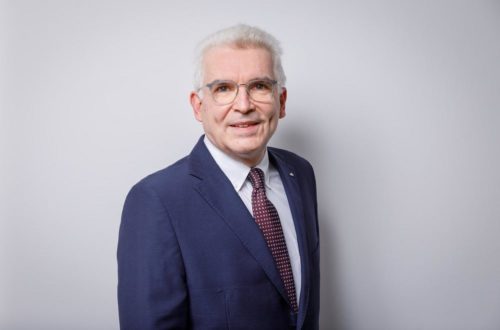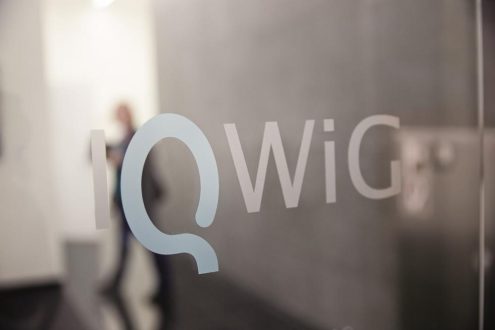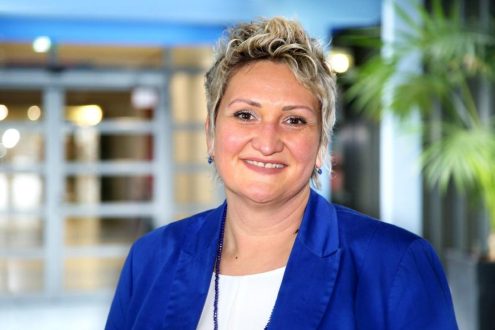MC 2023 ended successfully in Darmstadt: Exciting look into the nanocosmos with leading experts in electron microscopy
Microscopy methods and their applications in life sciences or material sciences were presented in seven thematic sessions each on the different main topics with 25 scientific sessions, 6 plenary lectures, award ceremonies, more than 90 oral presentations, 3 large poster sessions with more than 340 contributions and 23 lunch lectures. To complement the comprehensive scientific program, there were many well-attended workshops as well as an industrial exhibition of 43 exhibitors on the latest developments in microscopy and microscopy technology with various accessories and consumables, preparation tools and image analysis systems.
Top-class plenary speakers inspire in all areas
MC 2023, as the largest and most important scientific event in the field of electron microscopy in Europe, presented the latest findings and trends. The German Electron Microscopy Society (DGE) once again succeeded in bringing together leading experts from a wide range of disciplines and up-and-coming young researchers for a comprehensive professional exchange. In the Darmstadtium there were lively discussions on all five days of the congress on the latest findings in the fields of instrumentation and methods as well as bio- and material sciences.
Highlights of the congress were the presentations by renowned plenary speakers from a wide range of disciplines. With their new scientific research results, they were able to inspire the participants with excellent presentations. In the field of life science, Prof. Peijun Zhang, PhD, Oxford, presented the development and optimization of two- and three-dimensional imaging methods: "From cryoEM, cryoET to ptychography". Two high-profile presentations from the field of materials science addressed method developments in spectroscopy and in-situ imaging: Prof. Dr. Sarah Haigh, Manchester, spoke on "Atomic resolution dynamics imaged using 2D heterostructure liquid cells" and Prof. Dr. Mathieu Kociak, Paris, on "Enhancing electron spectroscopies using light". Among the abundance of interesting, qualitatively superior presentations, one plenary talk was of particular interest. In the packed plenary hall, 525 congress participants gathered for the highly topical presentation by Prof. Dr. Ralf Bartenschlager, Heidelberg, who highlighted the role of electron microscopy in combating the pandemic: "Integrative imaging analysis of the replication cycle of plus-strand RNA viruses."
Special highlights – outstanding award ceremonies
Special highlights were again the ceremonial award presentations, where scientists were honored for their outstanding achievements in the field of electron microscopy. This year, the research of two award winners was in the field of materials science. They addressed topics of method development in spectroscopy and in-situ imaging. The internationally renowned Ernst Ruska Prize, which is awarded every two years, was presented to Prof. Dr. Vincenzo Grillo, Gattatico. The awardee reported on new possibilities in electron microscopy with beam shaping: "New microscopy possibilities with electron beam shaping". The Harald Rose Lecture (HRL) was given by Prof. Philip E. Batson, Piscataway.
Dr. Max Haider represented Prof. Dr. Harald Rose in his eagerly awaited speech "From Micrometer to Sub-Angstroem resolution – the development" and captivated the numerous participants. In 1980, world-renowned physicist Harald Rose, who pioneered research in lens aberration correction at Darmstadt Technical University, had achieved the stroke of genius of making atoms visible to electron microscopes. Many new developments in high-resolution imaging, as well as the rapid advances in scanning methods, would not have been possible without these correctors.
Interdisciplinarity – the impetus for new developments
An important focus was on current tie-ins to the groundbreaking analytical advances of the last 20 years. Applications and developments of different techniques in the field of light and electron microscopy have become an integral part of most research areas. The broad and interdisciplinary MC 2023 made it clear that creative science combining the fields of life sciences, materials sciences, and methods technology continues to open up new opportunities to better understand life, as well as inorganic matter. The exchange of leading scientists in each special field and with internationally renowned experts opened the view beyond one’s own nose to learn about other aspects and to always initiate new developments in different fields.
Life Sciences – Materials Sciences – Instrumentation and Methods
Presentations by renowned experts highlighted the extent to which electron microscopy is opening up new opportunities for better understanding biological and medical processes, particularly in the field of life sciences. For example, in order to successfully combat a virus, it is crucial to know its structure. Time and again, it became apparent that important synergies can be created by using electron microscopy equally in the field of materials science, characterizing the structures of functional materials to optimize processes in the fields of energy and the environment, and to make materials more efficient and durable. In various sessions, it became clear that techniques and methods developed in life science research are also being used in materials science and vice versa.
In the presentation of the latest developments in the field of "Instrumentation and Methods", it became apparent that the improvement of instrumentation not only drives existing methods, but is often also a prerequisite for new methods. For example, the new generation of detectors that can detect electrons directly and without losses also enables significant advances of "in-situ"/operando methods. Meanwhile, processes in batteries and fuel cells can be directly observed even during reactions, further driving the development of new energy storage and generation systems.
Exciting was the presentation of newly designed devices in the field of 4D-STEM, for the analysis of material structures in four dimensions, as well as dedicated electron diffractometers, which can be used to gently elucidate the atomic structure of a single nanoparticle. Another focus was on new developments for correlative microscopy, the combination of electron microscopy with other imaging techniques for a more comprehensive characterization of samples. Tomographic methods were also presented to visualize the spatial distribution of particles, defects or chemical compounds in a material or biological tissue.
Automation and AI – a big topic
With excellent quality in all areas, the high-level congress showed how groundbreaking improvements and trends in electron microscopy have continued and how progressive automation and AI are becoming increasingly important. Standardization of sample preparation processes, as well as control of sample changes, data acquisition, reproducibility, and thus increasing efficiency of experiments, can bring actual data analysis and interpretation to the forefront. AI also supports experiments in automatically identifying structures in data acquisition and analyzing large amounts of data. A special workshop on data management addressed these issues and highlighted how the 4D-STEM method, coupled with in situ experiments showing material behavior in real time, benefits from these new techniques.
Conclusion and Outlook 2023
Fostering scientific collaboration and knowledge transfer played an important role at MC 2023. In addition to exceedingly lively debates and animated discussions, a large number of younger scientists took advantage of the congress to present their own research. The "Young Microscopist symposium" provided young scientists with the essential exchange of ideas and knowledge to gain new perspectives on their research topics, improve their skills and knowledge, and network. The concept of the two congress presidents that scientific exchange should be a mainstay of research was fully realized at this year’s Microscopy Conference: "The joint discourse made it possible to develop and implement new ideas," concluded Prof. Dr. Ute Kolb. "That was possible online even in times of the pandemic, but the networking you achieve in personal conversations at a conference has a different quality."
The diverse exchange between young colleagues, experienced scientists and companies as well as the exciting discussions and insights into the nanocosmos with further developments and trends can be continued at the next Microscopy Conference from August 31 to September 4, 2025 in Karlsruhe. This is planned as an EMS extension and will be jointly organized by the German Society for Electron Microscopy e.V. (DGE), the Swiss Society for Optics and Microscopy (SSOM) and the Austrian Society for Electron Microscopy (ASEM).
For more information on MC2025, visit the congress homepage at www.microscopy-conference.de.
Conventus Congressmanagement & Marketing GmbH
Carl-Pulfrich-Straße 1
07745 Jena
Telefon: +49 (3641) 311-60
Telefax: +49 (3641) 311-6241
http://www.conventus.de
PR Leiterin
Telefon: +49 (172) 3516916
E-Mail: kerstin.aldenhoff@conventus.de
![]()




